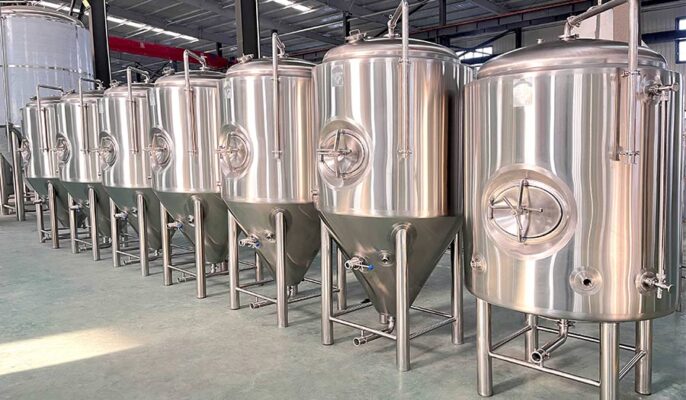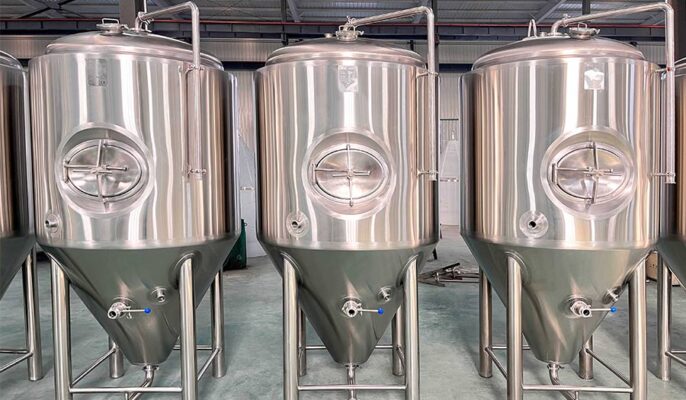발효 용기(FV) 또는 "발효기"는 효모가 맥주로 발효하는 동안 맥즙을 저장하는 곳입니다. 맥아즙(맥아 곡물에서 추출한 단맛이 나는 액체)을 많은 사람이 즐기는 맛있고 향기로운 음료로 변화시킵니다. 양조 과정의 초석인 발효기는 발효의 마법을 배양하는 데 중요한 역할을 합니다. 발효기는 다양한 모양과 크기로 다양한 재료로 만들어지며 현재 가장 인기 있는 발효기는 플라스틱, 유리, 스테인리스 스틸입니다.
무엇인가요? 발효기?
발효 탱크 또는 발효 용기로도 알려진 발효기는 발효를 위해 맥아즙이나 포도즙과 같은 기질을 담는 데 사용되는 용기입니다. 이 탱크는 효모나 기타 미생물이 설탕을 알코올과 이산화탄소로 전환하는 데 필요한 환경을 제공합니다. 발효기마다 다른 효모를 사용하여 다양한 제품을 발효시킬 수 있습니다. 맥즙은 맥주 효모를 사용하여 맥주로 발효됩니다. 맥주를 양조하는 발효 과정에서 효모가 설탕을 알코올로 전환하기 때문입니다. 발효기에서 바이오매스를 바이오가스로 전환할 수도 있습니다.
발효 탱크의 특징:
- 재질: 대부분의 발효 탱크는 내식성이 뛰어나고 세척이 용이한 스테인리스 스틸로 만들어집니다. 이는 최종 제품의 순도와 품질을 보장합니다.
- 온도 조절: 발효는 온도에 민감한 과정입니다. 최신 발효기에는 온도를 조절하는 냉각 재킷이나 내부 코일이 장착되어 있습니다.
- 밀폐된 환경: 오염을 방지하기 위해 발효 탱크는 밀폐되어 있습니다. 이 밀폐된 환경은 최종 제품의 일관된 품질을 보장합니다.
- 용량: 탱크 크기: 몇 갤런의 소형 홈메이드 탱크부터 수천 갤런을 담을 수 있는 대형 상업용 탱크까지 다양합니다.

양조에서 발효 탱크의 역할은 무엇인가요?
- 통제된 환경: 발효 탱크는 야생 효모, 박테리아, 공기 중 입자 등 외부 오염 물질로부터 발효 제품을 보호하는 밀폐된 환경을 제공하여 발효 과정의 순도를 보장합니다.
- 온도 조절: 많은 발효기, 특히 밀폐형 발효기에는 온도 제어 시스템이 장착되어 있습니다. 정확한 온도를 유지하는 것은 효모 대사와 발효 역학에 영향을 미치고 최종 제품의 풍미 프로필과 품질에 영향을 미치기 때문에 매우 중요합니다.
- 교반 및 혼합하기: 일부 발효기에는 교반기가 내장되어 있습니다. 적절한 혼합은 균일한 발효와 더 나은 온도 제어를 보장하고 특히 대형 탱크에서 효모 건강을 향상시킬 수 있습니다.
- 침전물 분리: 원뿔형 발효기와 같이 설계된 탱크는 효모와 기타 침전물이 바닥에 가라앉을 수 있도록 합니다. 이러한 설계는 제거 과정을 간소화하고 이후 여과 또는 랙킹 단계를 더 효율적으로 만듭니다.
- 탄산화: 특정 발효기, 특히 유닛 탱크는 탄산화 과정을 처리할 수 있습니다. 발효가 완료되면 동일한 탱크에서 음료를 탄산화할 수 있으므로 다른 용기로 옮길 필요가 없습니다.
맥주 발효 탱크의 종류
원뿔형 발효 탱크
원뿔형 발효기는 홈 브루어와 전문 브루어 모두에게 가장 인기 있는 발효기입니다. 원뿔형 발효기는 바닥이 가늘어져 효모와 침전물이 바닥에 가라앉아 모일 수 있어 발효 후 맥주를 찌꺼기(침전물)에서 쉽게 분리할 수 있습니다. 또한 이 디자인은 향후 배치에 재사용하기 위해 효모를 더 쉽게 수확할 수 있게 해줍니다.
바닥이 평평한 발효 탱크
평평한 바닥 발효기는 이름에서 알 수 있듯이 바닥이 평평하며 일반적으로 플라스틱이나 유리로 만들어집니다. 원뿔형 발효기보다 저렴하지만 맥주를 2차 발효기로 옮기거나 사이펀을 사용하여 배럴에서 맥주를 제거하는 등 침전물과 맥주를 분리하기 위한 추가 단계가 필요합니다.
원뿔형 발효 탱크
원추형 발효기는 원뿔형 발효기와 원통형 발효기의 혼합형 발효기로, 바닥이 원뿔형인 대형 원통이 특징입니다. 이 발효기는 다용도로 사용할 수 있어 상업용 양조장에서 사용되며, 동일한 용기에서 발효와 숙성을 진행할 수 있습니다. 또한 원뿔형 발효기와 마찬가지로 효모와 침전물을 제거하는 데 도움이 됩니다.
오픈 발효기
개방형 발효 용기는 발효기를 공기에 노출시켜 자연적인 공기 교환을 가능하게 하는 전통적인 발효 방법입니다. 이 방법은 야생 효모와 박테리아가 주는 독특한 풍미를 즐길 수 있는 벨기에 람빅이나 일부 영국 에일 맥주와 같은 특정 유형의 맥주에 자주 사용됩니다. 하지만 개방 발효는 오염 위험이 높기 때문에 불필요한 감염을 방지하기 위해 세심한 환경 관리가 필요합니다.
수평 맥주 캔
수평 맥주 탱크는 낮은 온도에서 발효 및 숙성 기간이 길어야 하는 맥주용으로 설계된 대형 원통형 탱크입니다. 수평 방향으로 배치되어 있어 온도 조절이 용이하고 효모를 쉽게 제거할 수 있습니다.
발효기 재료
- 스테인리스 스틸 소재: 스테인리스 스틸은 내구성이 뛰어나고 긁힘과 얼룩에 강하며 온도 조절이 잘 되기 때문에 많은 상업용 양조장과 전문 홈브루어리에서 선택하는 소재입니다. 하지만 스테인리스 스틸 발효기는 다른 옵션보다 가격이 비싼 경향이 있습니다.
- 유리 소재: 유리 발효 탱크는 발효 과정을 볼 수 있고 긁힘 방지 및 오염 방지 기능이 있습니다. 하지만 다른 소재보다 깨지기 쉬우므로 조심해서 다루지 않으면 깨질 수 있습니다.
- 플라스틱 소재: 플라스틱 발효 탱크는 가볍고 저렴하며 청소하기 쉽습니다. 하지만 긁힘에 더 취약하여 박테리아가 서식하고 오염을 일으킬 수 있습니다. 또한 일부 플라스틱 발효 탱크는 다른 옵션만큼 밀폐되지 않아 장기 보관이나 숙성에는 적합하지 않을 수 있습니다.
- 목재: 목재 발효기는 배럴 숙성 스타우트나 사워 맥주와 같은 특정 유형의 맥주에 사용됩니다. 목재는 맥주에 독특한 풍미와 개성을 부여하지만 오염을 방지하기 위해 각별한 주의와 관리가 필요합니다.

양조에서 발효기가 중요한 이유는 무엇인가요?
발효 과정에서 많은 양의 열이 발생하므로 적절한 온도를 유지하기 위해 발효 탱크가 필요합니다. 먼저 효모에 맥아즙을 넣고 혼합물의 비중을 측정합니다. 그런 다음 일정량의 중력을 다시 측정하여 맥주에 알코올이 얼마나 있는지 확인하고 발효 과정을 언제 중단해야 하는지 분석할 수 있습니다. 맥즙은 20°C에서 14일 동안 보관됩니다. 발효가 완료되면 효모는 원뿔형 발효기의 바닥에 가라앉습니다. 이 원뿔형 발효기를 사용하면 효모 침전물을 쉽게 제거하여 보존하고 다음 맥주 세트에 재사용할 수 있습니다. 좋은 발효기에 대한 초기 투자 비용이 높아 보일 수 있지만, 장기적으로는 폐기물 감소, 일관된 제품 품질 및 최적화된 생산 공정의 이점을 통해 상당한 비용 절감 효과를 얻을 수 있습니다.
올바른 발효기를 선택하는 방법은 무엇입니까?
양조를 하든 취미로 하든 올바른 발효기를 선택하는 것은 중요합니다. 이는 생산 품질과 효율성에 영향을 미칩니다. 다음은 몇 가지 선택 참고 사항입니다. 도움이 되길 바랍니다.
|
고려 사항 |
옵션 |
|
목적 |
맥주 양조, 포도주 양조, 유제품 발효 등 |
|
용량 |
5갤런, 50갤런, 500갤런 등 |
|
재질 |
스테인리스 스틸, 플라스틱, 유리 |
|
디자인 |
원뿔형, 평평한 바닥, 오픈탑 |
|
온도 제어 |
냉각 재킷, 내부 코일 |
|
예산 |
$5000 |




